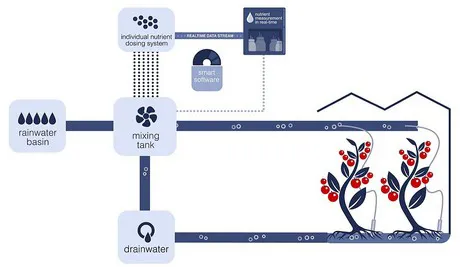Precise fertilization that meets the needs of the crop requires two things: you have to know the optimal fertilization of the crop, and you require a continuous insight in the actual fertilization condition. In both fields important steps are being taken at the moment.
The project Ion-specific cultivation has just been completed. Recently, sensors have been introduced on the market which are able to measure the concentration in the mat or drain per nutritional element (ion). In principle, this can be done continuously. Wageningen University & Research, business unit Glastuinbouw, is gong to test these sensors and will also chart what optimal fertilization yields in terms of production and energy.

Fluctuation in the mat
For various nutritional elements it is known that their content in the mat can vary significantly. This is because the intake is not always the same. The researchers: "Night and day are often worlds apart. The weather is also important for the intake. Potassium is a good example of an element which has a highly fluctuating content. In itself this is not a problem: with potassium, a lower intake on one day could very well be compensated by a higher intake the other day. But you need insight more often. A drain analysis once every two weeks masks the continuous fluctuation."
For potassium, this is not critical, but it is for calcium. "An insufficient intake leads to weak cells. How quickly this happens, remains the question, but it is certain you cannot wait for the drain analysis for two weeks. You actually have to adjust fertilization much quicker than that."
Sensors ready to use
Every reason to keep things under a tighter control. The sensors are ready, the next step is testing how they can be used in practice. Project coordinator Ellen Beerling: "We are first going to chart what sub-optimal cultivation costs in terms of production and energy. We do this by measuring the oxygen content in the mat, which is an indication for root activity. In this way we can determine the consequences of fluctuations in the mat. Important are the concentration of the individual nutrients, but also their proportion."
This part will tell whether it is useful to continuously measure ion-specifically. The fundamental idea is that production and quality can certainly be improved. "The second part of this project - a public-private cooperation - is the validation of the Celine sensor of The Sensor Factory in practice and coupling it to the control systems. This happens at various cultivation companies."
Basis for fertilization advice
The insights to be gained are planted in fertile soil. The Basis for Fertilization Advice has just been updated on request of the Club of 100, the suppliers contributing to the applied strategical research of WUR Greenhouse Horticulture. The Basis for Fertilization Advice had become a bit outdated in the course of time. Fertilization specialist Wim Voogt has used all current research results to update the Basis and conducted additional research. Read more about this research here (in Dutch).
Digital template model
The result is a digital template model in two versions: for substrate cultivation and for pot plants. The grower, who is filling out the template, received ready-made advice about additional nutrients. The system can also generate various overviews, such as concentrations in the mat and the drain, passage of individual elements, EC, and such. The updated Basis will be made widely available for the sector via the members of the Club of 100.
The project Ion-specific Measuring is being financed by KijK, Glastuinbouw Nederland, Topsector T&U, Interpolis, The Sensor Factory, Van Iperen, T. Stolze Installatietechniek, Priva, Royal Pride and Lans Westland.
Source: Kas als Energiebron
